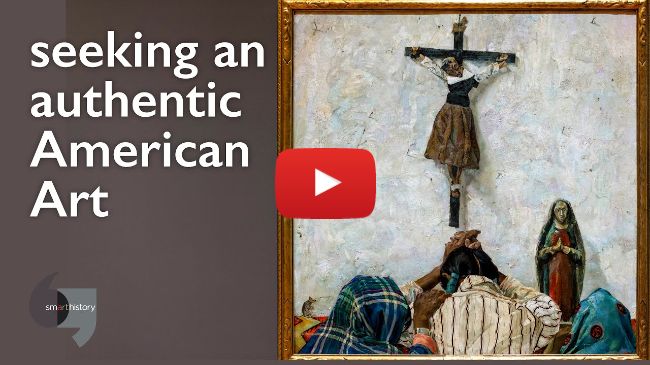You Can't Make This Stuff Up
Click here to see this email on the web |  | Friday, October 7, 2022 | | You Can't Make This Stuff Up | By Christopher Volpe | Share this article:     |  | Clyde Aspevig, "Morning Glory Pool" - Yellowstone 50x60" oil on stretched canvas | A strange flower grows in Yellowstone National Park in Wyoming, and its bizarre colors have stunned visitors and artists for over a century.
|  | This is Morning Glory Pool, not a flower but a thermal hot spring of such bright, saturated oranges, yellows, greens (and sometimes blues) that whoever named it decided the eponymous flower was the best analogy. About a mile away from Old Faithful, Morning Glory used to be more blue than the green you see in Clyde Aspevig's painting of it (above). Scads of sightseers since the 1880s have thrown in thousands of pounds of coins, rocks, trash, and logs, all of which clogged the hot spring's vent and changed its temperature and pH balance. This led to the unstoppable growth of bacteria that has made it look more green than blue. That's what people used to thing anyway - but it turns out that all the hot springs are seeing temperature (and color) changes, so pollution may be only part of the problem.
Confronted with this bizarre feature of the earth's chemistry, how should a landscape painter proceed? Many, I think, would not know where to begin. The color approach as Clyde Aspevig discovered, would be to "paint it straight," because otherwise no one would believe it. That still leaves the problem of an overly symmetrical "hole in the ground" composition though. To work around that, Aspevig zoomed in on and smoothed out the transitions in the incredible yellow-orange to green-blue progression. He also softened the detail in the rock surfaces and minimized the aperture at the bottom. These subtle simplifications give full play to what's beautiful about the phenomenon.
The following much earlier (c. 1895) painting by John Henry Twachtman is a rare departure from this New England Tonalist'smuted palette. This is a different pool not far from Morning Glory, dubbed The Emerald Pool (and that name fits better than ever, because it too has changed from green-blue to green over time). Twachtman solved the composition problem (avoiding canvas with a big "hold" in the middle of it) by cropping the image from one side, and he too smoothed out most of the detail, creating an almost entirely abstract painting in the process (pretty wild for 1895!). |  | John Henry Twachtman, Edge of the Emerald Pool, Yellowstone, c. 1895 | — advertisement — |  | Here is what the Park Service tells us about The Emerald Pool in Twachtman's painting:
Emerald Pool is a large steaming pool with thin, solidified sinter around the edge of the pool. Orange thermophiles line the bottom of the pool and throughout the outwash channel. Emerald Pool was once blue with some yellow thermophiles that caused its waters to appear green, hence its name. But like other pools in Black Sand Basin, a drop in water temperatures have resulted in the loss of the bright pools, with them being replaced with orange, murky pools.
Back to Blue Morning Glory You know the colors in these paintings by Twachtman and Aspevig are true to life because they're too weird and wonderful to have been flights of fancy. |  | Morning Glory, 2018, photo by Janet Jones | As you can see in the photo above, Morning Glory hot spring still turns blue on occasion, and in any case it's an incredible sight, and surely a challenge to any painter brave enough to attempt to do it justice. |
|
|
|
— advertisement — |  | Hunger for Authenticity | Walter User's Evocation of War & Pandemic in Post WWI America
German-American artist Water Ufer found in the American Southwest the foundation of what he believed could be a "truly American" art. A brief video, the latest in the "Smarthistory" series of conversations between art history professors Dr. Steven Zucker and Dr. Beth Harris, focuses on a powerful painting loaded with emotion as well as subtle symbolism. |  | As the above painting, Taos Plaza demonstrates, Ufer was capable of top-notch American-Impressionist landscape painting. But in his extraordinary work titled "The Hunger," the artist chose to go beneath the surface, to uncover a deeper layer of contemporary life in the immediate aftermath of WWI and during the onset of the deadly Influenza pandemic in America. The video linked below offers a reverant and softspoken commentary on the painting's subtly achieved emotional power. |  |
|
| | |
|
Inside Art is committed to protecting and respecting your privacy. We do not rent or share your email address. By submitting your email address, you consent to Streamline Publishing delivering regular email issues and advertisements. To end your Inside Art e-mail subscription and associated external offers, unsubscribe here. To learn more about Streamline Publishing events, products, and offerings visit StreamlinePublishing.com
Copyright 2022 Streamline Publishing, Inc. All rights reserved.
Inside Art® is a registered trademark of Streamline Publishing, Inc. |
|
|
|
|









No comments:
Post a Comment